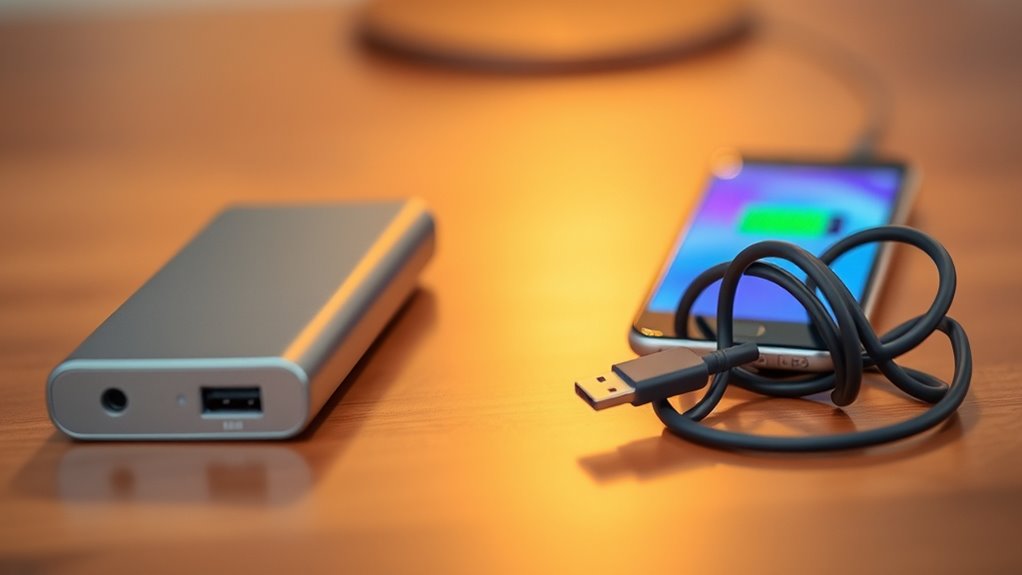When considering external battery chargers versus USB charging, external battery chargers win for portability and convenience. They let you recharge multiple devices without being tied to an outlet, making them perfect for on-the-go power. USB charging is quick and efficient when outlets are available but can be limiting. If you prioritize flexibility and the ability to stay connected wherever you are, external battery chargers are the way to go. Discover more details to help you choose the best option for your needs.
Key Takeaways
- External battery chargers offer greater portability, allowing charging on the go without the need for outlets.
- USB charging is faster and more efficient when near available power sources, ideal for quick top-ups.
- Power banks can charge multiple devices simultaneously and are perfect for travel and outdoor use.
- External chargers may feature fast-charging technology and smart capabilities for optimized device charging.
- The choice between the two depends on your mobility needs and the availability of power sources.

When you’re on the go and your devices start to run low, choosing between external battery chargers and USB charging can feel overwhelming. Both options have their merits, but understanding which one suits your lifestyle best can save you time and frustration. Let’s break down the differences, focusing on portable power and charging efficiency, so you can make an informed decision.
External battery chargers offer a reliable source of portable power. They come in various sizes and capacities, allowing you to pick one that fits your needs. If you’re frequently out and about, having a power bank that can recharge your smartphone several times can be a lifesaver. You won’t have to scramble for an outlet or worry about your device dying just when you need it most. The convenience of charging multiple devices simultaneously is another advantage, especially if you’re traveling with friends or family.
External battery chargers provide essential portable power, ensuring you stay connected without searching for outlets or sacrificing convenience.
On the other hand, USB charging—using a cable connected to a wall outlet, computer, or car charger—may seem simpler. It’s often faster and more efficient if you’re near a power source. However, it limits your mobility. If you’re stuck in a café or on a road trip without access to an outlet, you could find yourself in a tight spot. USB charging is typically the go-to method for quick top-ups, but it doesn’t always provide the flexibility you need in a pinch.
When it comes to charging efficiency, external battery chargers usually win out. Many modern power banks feature fast-charging technology. That means you can get a significant amount of juice in a short period, often faster than traditional USB charging methods. This is particularly useful if you’re in a rush and need to power up quickly. Additionally, some power banks come equipped with smart charging capabilities, which detect your device’s requirements and optimize the charging process accordingly. Moreover, just like how high refresh rates enhance gaming experiences, a good external battery charger can significantly improve your device’s usability on the go.
Ultimately, your choice depends on how you use your devices day-to-day. If you prioritize portability and the ability to charge multiple gadgets without being tethered to a wall, an external battery charger is the way to go. However, if you find yourself near power outlets often and need occasional rapid charging, USB charging might suffice. Consider your habits and environment; that’ll help you determine which option offers you the best balance of convenience and efficiency.
Frequently Asked Questions
Can I Use an External Battery Charger for All Devices?
You can use an external battery charger for many devices, but it depends on compatibility. Check if your device supports the charger’s output voltage and connector type. Battery capacity also matters; a charger with higher capacity can power your device longer, but it needs to match your device’s requirements. Always verify specifications to guarantee safe and efficient charging, so you don’t risk damaging your device or experiencing slow charge times.
How Long Do External Battery Chargers Typically Last?
External battery chargers typically last between 2 to 5 years, depending on usage and care. You’ll notice their battery lifespan can decrease over time, especially if you charge them frequently or expose them to extreme temperatures. Charger durability plays a significant role too; high-quality chargers can withstand daily wear and tear better than cheaper options. Regular maintenance, like keeping the contacts clean, can help extend their life even further.
Are USB Charging Speeds the Same for All Devices?
Think of charging speeds like different lanes on a highway. Not all devices travel at the same speed. USB charging speeds vary based on the device, charging cables, and power banks you use. For instance, a newer smartphone with fast charging capabilities can fill up quicker than an older model. So, if you’re using a high-quality cable and a compatible power bank, you’ll definitely notice a significant boost in charging speed.
Do External Battery Chargers Damage Battery Health Over Time?
External battery chargers can cause battery degradation if they’re not compatible with your device. Using a charger that delivers too much voltage or current can overheat and shorten your battery’s lifespan. However, if you choose a compatible charger and follow manufacturer guidelines, you shouldn’t see significant damage. Always opt for quality chargers to maintain your battery health, and monitor charging habits to make certain your device stays in good condition over time.
Is It Safe to Charge Devices Overnight Using USB?
Is it really safe to charge your devices overnight? Yes, it generally is, especially with modern USB chargers designed to manage power levels. They often include smart technology that prevents overcharging, promoting USB longevity. However, for ideal overnight safety, make sure you’re using quality cables and chargers. A little precaution can go a long way in preserving your device’s battery health while you sleep, giving you peace of mind for the next day.
Conclusion
When it comes to charging your devices, the choice between external battery chargers and USB charging boils down to your needs. If you’re constantly on the go, an external charger can feel like a superhero, saving the day with extra power. But if convenience is your jam, USB charging keeps things simple and straightforward. Ultimately, both have their perks, so choose what fits your lifestyle best. Happy charging!










